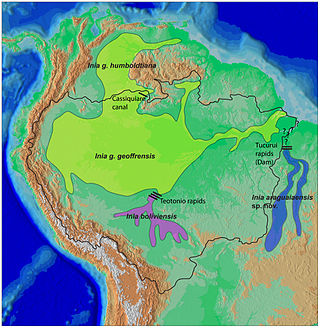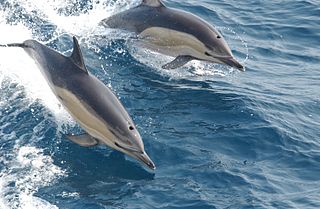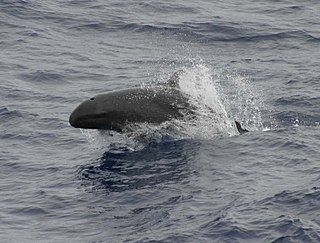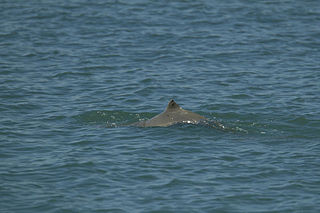
River dolphins are a polyphyletic group of fully aquatic mammals that reside exclusively in freshwater or brackish water. They are an informal grouping of dolphins, which itself is a paraphyletic group within the infraorder Cetacea. Extant river dolphins are placed in two superfamilies, Platanistoidea and Inioidea. They comprise the families Platanistidae, the recently extinct Lipotidae, Iniidae and Pontoporiidae. There are five extant species of river dolphins. River dolphins, alongside other cetaceans, belong to the clade Artiodactyla, with even-toed ungulates, and their closest living relatives the hippopotamuses, from which they diverged about 40 million years ago. Specific types of Dolphins can be pink.

Oceanic dolphins or Delphinidae are a widely distributed family of dolphins that live in the sea. Close to forty extant species are recognised. They include several big species whose common names contain "whale" rather than "dolphin", such as the Globicephalinae. Delphinidae is a family within the superfamily Delphinoidea, which also includes the porpoises (Phocoenidae) and the Monodontidae. River dolphins are relatives of the Delphinoidea.

The Irrawaddy dolphin is a euryhaline species of oceanic dolphin found in scattered subpopulations near sea coasts and in estuaries and rivers in parts of the Bay of Bengal and Southeast Asia. It closely resembles the Australian snubfin dolphin, which was not described as a separate species until 2005. It has a slate blue to a slate gray color. Although found in much of the riverine and marine zones of South and Southeast Asia, the only concentrated lagoon populations are found in Chilika Lake in Odisha, India and Songkhla Lake in southern Thailand.

The common dolphin is the most abundant cetacean in the world, with a global population of about six million. Despite this fact and its vernacular name, the common dolphin is not thought of as the archetypal dolphin, with that distinction belonging to the bottlenose dolphin due to its popular appearances in aquaria and the media. However, the common dolphin is often depicted in Ancient Greek and Roman art and culture, most notably in a mural painted by the Greek Minoan civilization.

The false killer whale is a species of oceanic dolphin that is the only extant representative of the genus Pseudorca. It is found in oceans worldwide but mainly in tropical regions. It was first described in 1846 as a species of porpoise based on a skull, which was revised when the first carcasses were observed in 1861. The name "false killer whale" comes from having a skull similar to the orca, or killer whale.

The melon-headed whale, also known less commonly as the electra dolphin, little killer whale, or many-toothed blackfish, is a toothed whale of the oceanic dolphin family (Delphinidae). The common name is derived from the head shape. Melon-headed whales are widely distributed throughout deep tropical and subtropical waters worldwide, but they are rarely encountered at sea. They are found near shore mostly around oceanic islands, such as Hawaii, French Polynesia, and the Philippines.

Fraser's dolphin or the Sarawak dolphin is a cetacean in the family Delphinidae found in deep waters in the Pacific Ocean and to a lesser extent in the Indian and Atlantic Oceans.

The northern right whale dolphin is a small, and slender species of cetacean found in cold/temperate waters of the North Pacific Ocean, that lacks a dorsal fin. It is one of two species of right whale dolphins.

The southern right whale dolphin is a small and slender species of cetacean, found in cool waters of the Southern Hemisphere. It is one of two species of right whale dolphin. This genus is characterized by the lack of a dorsal fin. The other species, the northern right whale dolphin, is found in deep oceans of the Northern Hemisphere and has a different pigmentation pattern than the southern right whale dolphin.

The pantropical spotted dolphin is a species of dolphin found in all the world's temperate and tropical oceans. The species was beginning to come under threat due to the killing of millions of individuals in tuna purse seines. In the 1980s, the rise of "dolphin-friendly" tuna capture methods saved millions of the species in the eastern Pacific Ocean and it is now one of the most abundant dolphin species in the world.

Cetacean bycatch is the accidental capture of non-target cetacean species such as dolphins, porpoises, and whales by fisheries. Bycatch can be caused by entanglement in fishing nets and lines, or direct capture by hooks or in trawl nets.

The Australian snubfin dolphin is a dolphin found off the northern coasts of Australia. It closely resembles the Irrawaddy dolphin and was not described as a separate species until 2005. The closest relative to the genus Orcaella is the killer whale, Orcinus orca. The Australian snubfin has three colors on its skin, while the Irrawaddy dolphin only has two. The skull and the fins also show minor differences between the two species.

The Australian humpback dolphin is a species of humpback dolphin and the fourth recognized humpback dolphin species chronologically. The specific name sahulensis is derived from the Sahul Shelf, located between northern Australia and southern New Guinea, where the Australian humpback dolphins occur.















